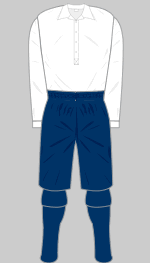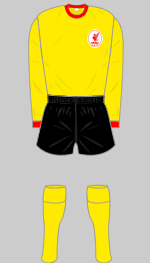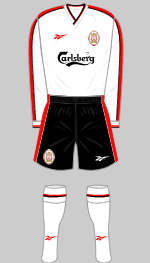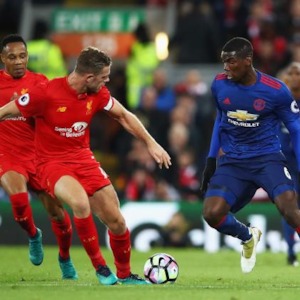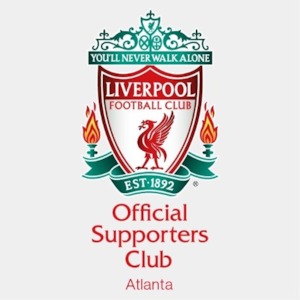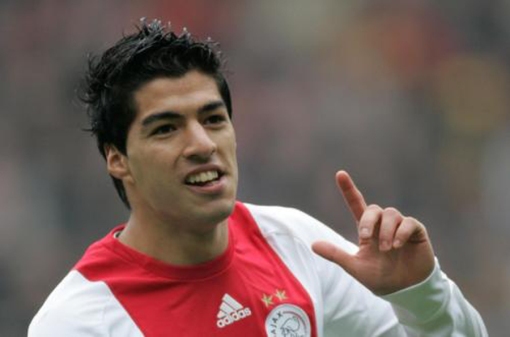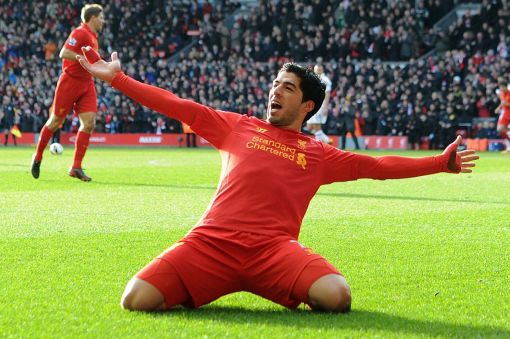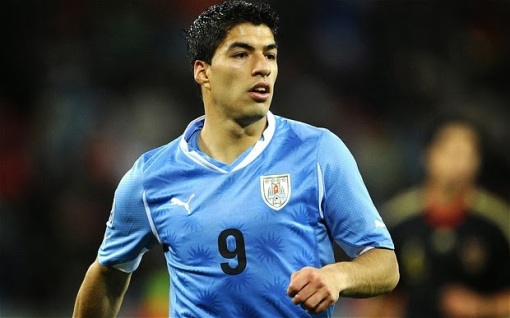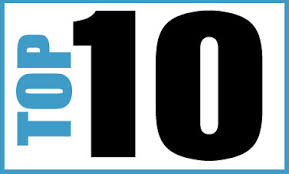Due to my technological backwardness, my family has a functioning VHS player that we still use. I mean how else am I going to watch Batman: The Movie (1966) or my Euro 2000 tapes or both tapes of Titanic? (Please note, the Titanic reference is made for comedic effect. I have never watched, nor ever will watch, James Cameron’s multimillion dollar epic about an incident in which everyone is fully aware of the outcome.) Going through old VHS tapes, I came across one called Goals Galore. I don’t even know where I picked it up, but the tape is full of goals from the 1988-89 English First Division season, which came down to the last moment of the last game of the season. Watching the video again, I couldn’t help but notice the 80’s graphics and music—alternating synthesizer and electric guitar. Timeless. The 20 minute show (there is only one replay of a goal) captures a time that featured the following:
- A skinnier Le Tissier and a young Tony Cottee
- Ugly unis and short shorts. The unis can still be ugly at times but the nuthuggers are a thing of the past.
- The Chris Waddle mullet
- Crisp handshakes and jubilant jumping for celebrations
- Roy Wegerle
- “very tidy finish”
- Awful pitches, especially through the middle and in the penalty areas
- Steve McMahon: Had a professor at GLCC who found out I liked soccer and he asked how Steve McMahon was doing. I was like Steve MacManaman? Great. No, he said, McMahon. Me, shrug of shoulders. That’s the last time we talked about soccer.
- Glenn Cockerill. Every time I watch this video I am struck by two things about this player: he had a cannon for a shot and always seemed to be angry.
The video climaxed with a goal scored on May 26th 1989, which is probably not an important date to American sports fans. A quick google search produced this selective list of significant sporting moments on that date:
1911 – 1st Indianapolis 500 auto race is run
1925 – Detroit Tigers’ Ty Cobb is 1st to collect 1,000 extra-base hits (ends 1,139)
1973 – Chicago White Sox beat the Cleveland Indians, 6-3, in 21 innings
1984 – Frisbee is kept aloft for 1,672 seconds in Philadelphia, PA
1990 – Philadelphia Phillies retire Mike Schmidt’s uniform #20
1992 – Carlos Martinez hits a ball off Jose Canseco’s head for a home run
For European soccer fans, the date might be of some significance:
1982 – Aston Villa wins 27th European Cup in Rotterdam
1993 – Olympique Marseille wins 38th European Cup in Munich
In fact, I get the sense that Americans don’t really do dates. References are typically to Super Bowl whatever or game such and such of a series, or simply the Greatest Game Ever Played (1958 NFL Championship Game). But I’m sure if you asked any long term (and long suffering) Arsenal or Liverpool fan what happened on May 26th 1989, they can probably tell you where they were, what the lineups were and what their reaction was at full time.
Looking at the final table from that campaign there were plenty of names that I recognized from my early days of following the game, some of which have since disappeared from the top flight—Derby County, Nottingham Forest, Wimbeldon, and Luton Town (who finished 16th and I don’t know anything about them). Then there was Newcastle United, who were relegated that season. Further research revealed that Chelsea won promotion from League Two (now the sponsored Championship) for the 1989/90 season and the Blues haven’t looked back since.
On the transfer front, several moves caught my eye:
- Ian Rush back at Liverpool (to help fire in the goals)
- Gazza moved from Newcastle to Spurs (first of many moves in an unfulfilled career)
- Mark Hughes returned to Manchester United from Barca (part of the attack that would end years of frustration)
- Gordon Strachan went to Leeds from Manchester United (would help the Yorkshire club claim the last First Division title in 1992)
- Chris Waddle went to Marseille (part of a wave of English players abroad, a trend that has since been reversed)
This was also the season that ITV started showing live Sunday afternoon games, which would eventually led to the television explosion, the formation of the Premier League, and a totally different footballing landscape in 20 years. But really the 88/89 season was about the tragedy of Hillsborough. That afternoon unfortunately overshadowed one of the greatest finishes in sporting history.
Setting the stage . . .
Arsenal had two wobbles during their season. (Tangent: One interesting fact that I found in my research was that Arsenal have not been relegated since 1919, which is impressive.) In late November and early December the Gunners lost away to Derby and drew at home with Liverpool and away to Norwich. From there they had an impressive run of seven wins and one draw until their next dip in form in February and March, only winning once in six matches, with two losses and three draws.
Reviewing the roster, interesting to see how many of that team have gone into broadcasting and coaching:
- Steve Bould coach in Arsenal youth set up; assistant to Wenger
- Lee Dixon pundit for ITV
- Nigel Winterburn TV
- David O’Leary coach at Leeds, Aston Villa and Al-Ahli
- Brian Marwood executive at MCFC
- Alan Smith game announcer for Sky Sports
- Paul Merson Young Player of the Year for 1988-89 and now a match reporter and pundit for Sky Sports
Liverpool were the defending Division One Champions and going for the Double again, having been denied the previous season by Wimbledon’s Crazy Gang in the FA Cup Final. What a team: John Barnes, Bruce Grobbelaar, Alan Hansen, Steve Nicol, Ray Houghton, Steve McMahon, John Aldridge, Peter Beardsley and Ian Rush.
A string of five straight draws early in the season created the gap the Reds would try to overcome the entire season. After a 3-1 loss at Old Trafford at the halfway point of the campaign, Liverpool won 15, drew 3 and lost once, but it was the one loss (and the margin of defeat) that cost them the crown.
The aftermath of Hillsborough led to a fixture pile up for the Champions, with the Reds having to play eight games in the month of May as they fought on two fronts in search of both major domestic trophies.
LFC run-in:
League 03/05/1989 Everton Away D 0-0
FA Cup SF 07/05/1989 Nottingham Forest N W 3-1
League 10/05/1989 Nottingham Forest Home W 1-0
League 13/05/1989 Wimbledon Away W 2-1
League 16/05/1989 Queens Park Rangers Home W 2-0
FA Cup Final 20/05/1989 Everton N W 3-2
League 23/05/1989 West Ham United Home W 5-1
League 26/05/1989 Arsenal Home L 0-2
For a long time I thought Arsenal won the game 1-0 because I only saw Michael Thomas’ last gasp goal over and over and over again. Only years later did I learn that Arsenal had to win by 2 clear goals.
Explanation of criteria via wikipedia
A victory for Arsenal would have brought both teams level on points. Arsenal’s victory by two clear goals meant that they won the title on goals scored. A three-goal deficit or more would have won Arsenal the title on goal difference. Any other result (i.e. a Liverpool victory, a draw, or an Arsenal win by one goal) would have secured the title for Liverpool. Liverpool had not lost by two or more goals at Anfield in three years, and Arsenal had not won there in fifteen. Furthermore, Liverpool had never previously been defeated when playing forwards John Aldridge and Ian Rush together. Liverpool were therefore the overwhelming favourites to win the title – the Daily Mirror’s sports sections led with the headline “You Haven’t Got A Prayer, Arsenal”.
I cannot examine this moment in time without referencing Nick Hornby’s Fever Pitch. As a lifelong Arsenal fan, he had achieved one of his goals by moving near Highbury during the winter of this amazing season. Hornby’s account of this dramatic day is in contrast to the movie interpretation. In the book there is excitement, even hope, especially after Smith’s goal, while in the movie, Colin Firth’s recreation of Paul from the film version is nervous and negative yet clinging to a sliver of hope. I could totally relate and watching the scene from the film took me back to 1999 and United’s Great Escape against Bayern Munich. The minutes at Anfield ticked away and even after Smith’s early second half goal, Arsenal still had everything to do. And just when all was lost, this happened. Nothing can beat the announcer’s comment in the moment—“An unbelievable climax to the league season.”

George Graham’s men won the First Division for the first time since 1971 and took the title out of the city of Liverpool for the first time in seven years. Liverpool would rebound and win the title in 1990 with Arsenal reclaiming the throne in 1991. And then both teams went silent. One more than the other. As I was dinking around, it occurred to me that Liverpool last won the title in 1990. The Reds from Liverpool are near the dreaded number 26 that the Reds from Manchester suffered through. Maybe they will have a rebirth like United, who went 26 without the trophy, then couldn’t stop winning them. Let’s hope not.






